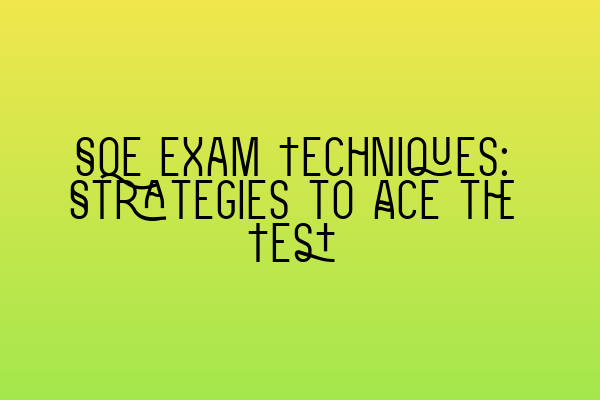SQE Exam Techniques: Strategies to Ace the Test
Welcome to our comprehensive guide on SQE exam techniques! If you’re preparing to take the Solicitors Qualifying Examination (SQE), you’ve come to the right place. In this blog post, we’ll cover essential strategies to help you ace the test and maximize your chances of success. So, let’s dive in!
The SQE Exam: What You Need to Know
If you’re unfamiliar with the SQE, we recommend checking out our article on Unveiling the Solicitors Qualifying Examination (SQE): What You Need to Know to get up to speed. Understanding the exam structure, content, and scoring system is crucial to developing effective study strategies.
Preparation Is Key
First and foremost, it’s important to recognize the significance of thorough preparation. Without proper preparation, even the most skilled candidates can struggle to perform at their best. To help you in this regard, we’ve compiled a list of Comprehensive SQE Prep Resources that will be your key to exam readiness.
Develop a Study Schedule
Creating a study schedule is vital to ensure efficient use of your time and resources. You can refer to our article on Tips for SQE Success: Key Pointers for a Stellar Performance to learn how to create an effective study schedule that suits your learning style and commitments.
Maximize Your Practice with Mock Tests
One of the most effective ways to prepare for the SQE is by taking mock tests. Mock tests simulate real exam conditions and allow you to familiarize yourself with the format and timing of the test. Our article on SQE Mocks Unleashed: Maximizing Your Preparation with Realistic Practice will provide you with valuable insights on how to maximize your practice sessions.
Moreover, we offer Free SQE Mock Tests that allow you to test your skills and assess your exam readiness. Take advantage of these free resources to gain confidence and identify areas that require additional focus.
Effective Exam Techniques
In addition to proper preparation, employing effective exam techniques can significantly improve your performance. Here are some strategies to consider:
Read the Instructions Carefully
Before diving into the questions, take a moment to read the instructions carefully. Understanding the requirements and expectations outlined in the instructions will help you answer the questions more effectively.
Manage Your Time
Time management is crucial during the SQE exam. Allocate specific amounts of time to each question or section and stick to your schedule. This will ensure that you have sufficient time to answer all the questions and avoid leaving any unanswered.
Annotate and Prioritize
As you read through the exam questions, make sure to annotate any key information that may be useful later. Prioritize your answers based on the marks allocated to each question. This will help you allocate your time and effort accordingly.
Focus on Structure and Clarity
When writing your answers, focus on presenting your ideas in a clear and logical structure. Use headings, bullet points, and paragraphs to organize your thoughts and make them more comprehensible to the examiner.
Revise and Review
Time permitting, always allocate a few minutes at the end of the exam to revise and review your answers. Check for any errors, omissions, or areas that require clarification. This final review could make a significant difference to your overall score.
By implementing these exam techniques, you’ll be well on your way to acing the SQE.
Final Thoughts
Preparing for the SQE exam requires a combination of diligent study and the application of effective exam techniques. By utilizing the strategies outlined in this article, and making use of the related resources we’ve provided, you can enhance your chances of success and achieve the results you desire.
Good luck and remember, practice makes perfect!

Leave a Reply